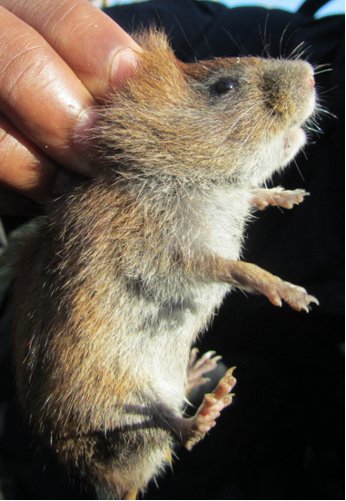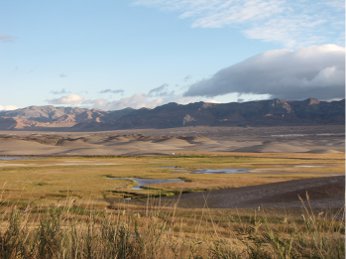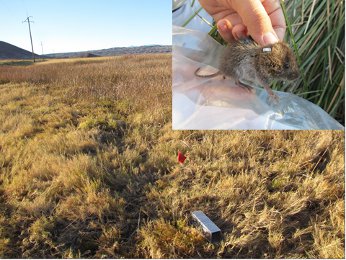Lead CDFW biologist: Tammy Branston
Natural History of Amargosa Voles
 Endangered Amargosa vole in hand.
Endangered Amargosa vole in hand.
 Tecopa Hot Springs / Grimshaw Lake Natural Area, showing typical vole habitat.
Tecopa Hot Springs / Grimshaw Lake Natural Area, showing typical vole habitat.
 Trapping Amargosa voles allows for research on these small rodents.
Trapping Amargosa voles allows for research on these small rodents.
The Amargosa vole (Microtus californicus scirpensis) is a desert subspecies of the widely distributed California vole (M. californicus). The Amargosa vole inhabits highly localized and isolated wetlands in the central Mojave Desert in extreme southeastern Inyo County, just east of Death Valley National Park. With the extremely limited distribution of the Amargosa vole, it is considered to be one of the most narrowly distributed subspecies of mammals known. It has been estimated that no more than one square kilometer (247 acres) of uneven patchy habitat for this species remains (Murphy and Freas, 1988), making this species extremely vulnerable to extinction from stochastistic events and habitat alterations.
The Amargosa vole was thought to be extinct in the early 1900' s and was rediscovered by CDFW biologist Vernon Bleich in the late 1970' s. It was listed as a California State Endangered species in 1980 (Title 14 California Administrate Code, Section 670.5) and as a Federal Endangered species, with designated critical habitat, in 1984 (49 FR: 45160). A recovery plan for the Amargosa vole was published in 1997. Pursuant to this plan, the Amargosa vole is a subspecies considered to be under high threat and has been given a recovery priority of six.
The existence of the endemic Amargosa vole depends on desert wetland vegetation dominated by American-threesquare ( Schoenoplectus americanus syn Scirpus americanus, S. olneyi). These wetlands usually exist as small, isolated patches, rarely exceeding five acres. These small, rare habitats, and thus the range of the Amargosa vole, historically occurred along the Amargosa River corridor from Shoshone, California to the northern portion of the Amargosa Canyon south of Tecopa, California. Due to habitat modification, invasive species such as salt cedar (Tamarix ramosissima), water diversion, and groundwater withdrawals, only a fraction of the historic suitable Amargosa vole habitat remains. The remaining suitable habitat is primarily located in and around Tecopa Hot Springs, California, some of which is on unprotected private lands.
Little is known about the basic life history or habitat requirements of the Amargosa vole and little information is available on the presence and distribution of the Amargosa vole within the species' limited range. Without obtaining this essential information, effective management and recovery for the species is unlikely. Urgent data are needed to determine if vole population numbers are decreasing or stable, to determine prevalence and impact of infectious diseases, and to assess genetic variability in order to work toward protecting and enhancing sustainable populations of this species.
Management activities to study and protect the Amargosa vole and its habitat will also benefit a broad array of unique species that are dependent on wetland vegetation in the harsh desert environment. These include an array of riparian songbirds, at least eight subspecies of pupfish and speckled dace, endemic spring snails, native amphibians, such as the Amargosa toad, and endemic beetles.
CDFW began comprehensive surveys on the Amargosa vole and conducted an intensive mark/recapture trapping effort in September 2010 over all potential and historic habitats to acquire an updated range, distribution and relative abundance of this species. During this effort CDFW documented a high prevalence of deformities associated on the vole' s ears and genitalia, which includes ear swelling, necrosis, and loss of tissue (CDFW, unpublished). Drs. Deana Clifford (CDFW), as well as Janet Foley, and Leslie Woods at UC Davis discovered that voles are being infested by a tiny parasitic mite that is associated with necrotic skin disease. This is the first documented disease for the Amargosa vole: a host of other parasites as well as viral and bacterial pathogens could spillover from extant and invasive animals in the Amargosa ecosystem and help drive the vole towards extinction. Genetic research conducted in 2002 revealed that the species has low genetic diversity suggesting the population could have difficulty adapting to new and existing pressures (Neuwald, 2010).
A more detailed analysis of the dynamics of dispersal and gene flow as well as the source-sink properties of this population are being pursued in coordination with federal agencies and non-profit organizations for establishing an effective management strategy for this species. Data collection will not only provide demographic information, but will also help determine how environmental pressures such as the prevalence and impact of infectious diseases, competition with exotic rodents or predation by feral animals, impact the Amargosa vole' s population structure and habitat use. By collecting this information, managers will be in a better position to recover the species through informed habitat restoration and species recovery efforts.
Owens Valley Vole Conservation